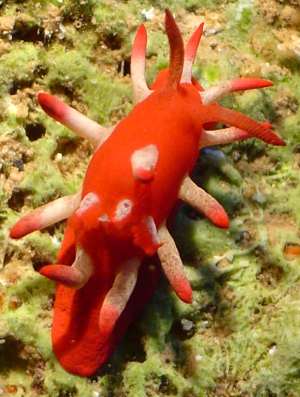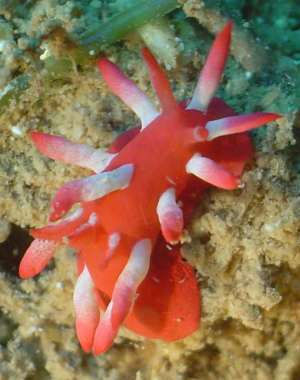Okenia nakamotoensis from the Indian Ocean
December 22, 2004
From: Marina Poddubetskaia


Dear Bill,
Probably, this is the most common species in Mayotte. I saw this species in many diving sites and in really huge numbers. It is probably due to the abundance of its food, the bryozoan Tropidozoum cellariiforme (see my second message - message #11505 ).
The identification of this species could be seen in the book Coral Reef Animals of the Indo-Pacific by Gosliner, Behrens, Williams. This book gives the identification of Okenia sp. food too.
I have asked Shireen Fahey if this species could be Hopkinsia nakamotoensis, very similar externally. Shireen told me that this one is a distinct species and it could be distinguished externally from H. nakamotoensis according to its foot which is smaller than the wider foot of Hopkinsia.
Location : M'Sapere, Mayotte Island, France, Indian Ocean
Site : Bouzi. Date: November 05, 2003
Photo 1: Depth : 8 m. Size : 10 mm
Photo 2: Depth : 7 m. Size : 8-10 mm
Photos: Marina Poddubetskaia
Best wishes,
Marina.
nembro@nembro.info
Poddubetskaia, M., 2004 (Dec 22) Okenia nakamotoensis from the Indian Ocean. [Message in] Sea Slug Forum. Australian Museum, Sydney. Available from http://www.seaslugforum.net/find/11504Dear Marina,
Thanks for this interesting contribution. Although we would need to have a look at its anatomy to be 100% certain, I am pretty sure this is indeed Okenia nakamotoensis . It agrees in colour pattern, number of mantle papillae, and food bryozoan [if your identification of the food is correct]. I think Shireen's concern about the width of the foot is unnecessary, as in this species the foot seems quite narrow when its on its food, but in fact that is beacuse it is wrapped around the narrow bryoan 'stalk'. When it is crawling on a flat surface the foot appears much wider. In your 2 photos the upper animal appears to have a much narrower foot them the lower one. Of the two species which feed on this bryozoan, Okenia kondoi is the one with the narrow foot. If my identification is correct, this is an interesting extension of the range of this species from Indonesia and the central west Pacific across to the western Indian Ocean.
I should have added this record to my recent paper on this genus, but I am afraid the only way I had time to do research was to ignore the growing stack of messages on the Forum which unfortunately meant that 3 or 4 on Okenia were missed by me.
Best wishes,
Bill Rudman
Related messages
-
Okenia nakamotoensis from Mabul Island, Malaysia
From: Paul Osmond, August 1, 2007 -
Okenia nakamotoensis from Sabah, Malaysia
From: Dave Morgan, December 1, 2005 -
Okenia nakamotoensis - feeding observations
From: Marina Poddubetskaia, December 22, 2004 -
Radula of Okenia nakamotoensis
From: Bill Rudman, December 21, 2004 -
Hopkinsia - final photos from Kwajalein
From: Scott Johnson, April 9, 2002 -
Hopkinsia from Enewatak Atoll
From: Scott Johnson, April 8, 2002 -
Hopkinsia - Kwajalein Photos (1)
From: Scott Johnson, April 8, 2002 -
Hopkinsia - Kwajalein photos (2)
From: Scott Johnson, April 8, 2002 -
Hopkinsia nakamotoensis from the Marshalls
From: Scott Johnson, March 4, 2002 -
Re: Hopkinsia? or Okenia? sp.
From: Erwin Koehler, February 19, 2002 -
Hopkinsia? or Okenia? sp.
From: Atsushi Ono, February 16, 2002 -
Hopkinsia? or Okenia? sp.
From: Bernard Picton, March 26, 1998 -
Hopkinsia? or Okenia? sp.
From: Erwin Koehler, March 20, 1998 -
Hopkinsia? or Okenia? sp.
From: Erwin Koehler, March 16, 1998
